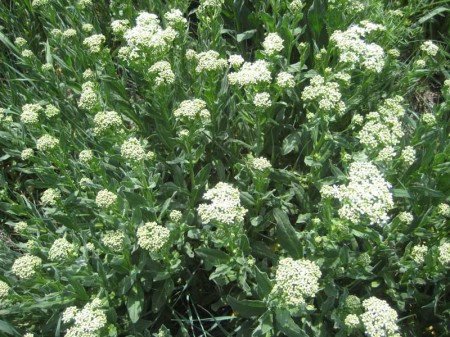
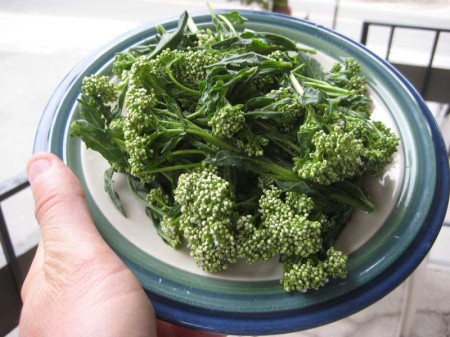
I’d been meaning to try eating whitetop, aka hoary cress (Cardaria spp., Lepidium draba or related Lepidium sp.)—an invasive plant targeted for eradication in many parts of the West. It saddens me to see whitetop taking over entire fields; I always wonder what plants might grow there if that hoary mustard hadn’t so asserted itself.
Last summer, when Colorado wild edible plants expert Cattail Bob Seebeck gave me my first taste of whitetop flowers in a farm field in Mesa, it nearly burned my tongue off—a seriously spicy mustard. Which is why I was so surprised that my friend Butter found it to be pleasant and mild prepared in the style of broccoli rabe. She harvested the tops before the flowers opened, including a small portion of stem and leaves, then blanched and sautéed the hoary cress with salt, red pepper flakes, and red wine vinegar.
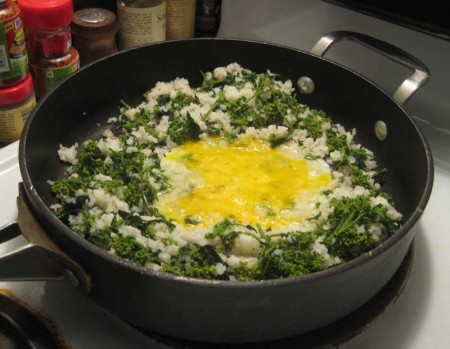
Whitetop Broccoli in Fried Rice
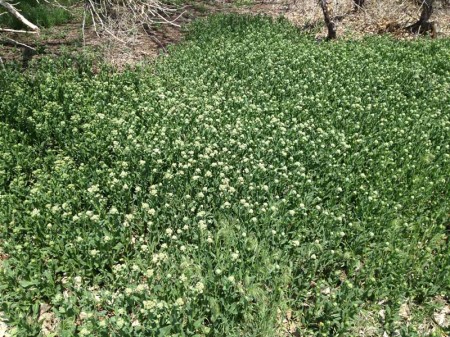
A couple of nights ago I took a page out of Butter’s book and used some “whitetop broccoli” I harvested recently from Fort Collins in a simple preparation—steamed for approximately 8 minutes and served atop refried rice with oil, soy, salt and an egg scrambled in with it.
Gregg’s take was that the whitetop faux broccoli is somewhat like broccoli in texture, but with some of the bite of Brussels sprouts. A broccoli fan through and through, he kept uttering: “I just can’t believe that whitetop broccoli. I just can’t believe it.”
One thing to note is that whitetop is often targeted for herbicide spraying, so it should be collected where that’s unlikely to happen, and obviously where plants are not deformed and curled inward upon themselves as if being tortured (poor things), which is what they look like when sprayed.
Whitetop & Oyster Mushrooms Quiche
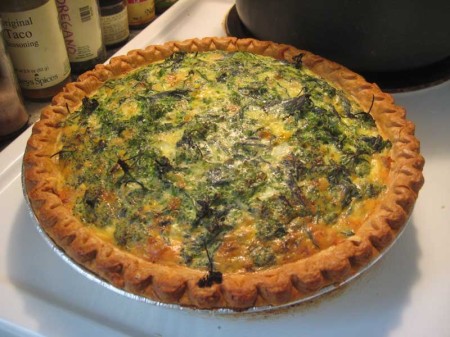
Next, I took the whitetop-as-broccoli experiment to something fancier—a twist on a broccoli quiche recipe from The Joy of Cooking. I used whitetop for broccoli, milk in place of cream, Parmesan cheese instead of Gruyere, and added fresh oyster mushrooms, using the tougher parts of the mushroom stems so we could save the soft, gilled caps for another recipe. To replicate it:
Ingredients:
½ – 1 cup oyster mushrooms, sliced thin
½ medium onion, chopped
butter and/or oil
1 tbsp dried feral garlic flakes (or onion flakes)
1 packed cup whitetop, upper stem & leaf bits chopped into chunks, with flower bud clusters intact
3 eggs
1 cup milk
½ tsp salt
¼ tsp ground pepper
¾ cup grated Parmesan cheese
Instructions:
- Preheat oven to 375.
- Sauté oyster mushrooms in butter until golden brown; then set aside.
- Sauté chopped onion together with onion flakes until the onions are translucent; then set aside.
- Blanch whitetop in boiling water for one minute; then strain.
- Mix eggs, milk, salt, and pepper.
- In a frozen pie shell (or pre-baked fresh), layer Parmesan cheese, oyster mushrooms, onions, and blanched whitetop; then pour custard mix on top.
- Bake for 25-35 minutes or 40-45 if you’re at 10,000 feet like me—basically until the custard sets and becomes light golden brown.
This recipe was fairly decadent, despite the omission of heavy cream, and turned out to be a big hit in our house—as evidenced by Gregg’s happy and incredulous moans for the duration of brunch and subsequent consumption of the leftovers.
Updated 2.21.21


I agree with G about the tasting a touch of brussels sprouts in this plant.
Thanks for finding that information from Cattail Bob. Good to know. I will add an update.
Hoary Cress is indeed quite delicious cooked up. We like it blanched with homemade mayonnaise. Unfortunately this plant is way too tenacious… We have an organic permaculture farm outside Spences Bridge, British Columbia (with an in season all organic bistro as well- Solstace to Equinox, weekends from 10-7). This weed popped up in a garden that we had left fallow for a couple of seasons. The last few years we’ve been cardboard mulching with thick layers of hay, and the hoary cress has been thriving. We’ve been aggressively pulling it out and laying it down or feeding it to our goats and it keeps on coming so aggressively, until all of the mulch has disappeared and the hoary cress takes over.
I recommend keeping this plant out of your garden, and if you see a sign of it, pull it quick and get rid of it- boil it up or make a fritatta.
Thanks for that account, Michael. It’s a good reminder that when foraging whitetop, we should take care not to spread seeds to new locations. Collect buds before they open and go to seed. Dispose of flowering parts in a thick garbage bag rather than on the mulch pile. Clean shoes/pants of seeds after walking through a patch before journeying to the next location. Cheers.
Thank you for this post! I’ve been trying to figure out the name of this plant that seems to grow all over the place. I love taking advantage of free greens!
I think I’ll definitely always cook this, in lots of water, which removes the bitterness. But I don’t like the texture of the cooked leaves (kind of like chewing on a wad of wet paper towels haha), so I chop it up and add it to rice & beans types of salads. Works great.
Good to know that it’s not toxic, especially if cooked.
I’m excited to get gathering next spring when hoary cress starts over again. Another similar plant is tall white top (Lepidium latifolium) (also called perennial pepper weed/broad leaved pepper weed). I’m guessing it would be similar, but have you ever eaten it? (https://plants.usda.gov/home/plantProfile?symbol=LELA2)
Yes! I absolutely have eaten Lepidium latifolium. It is quite strong-flavored. The very early spring leaves are best, in my opinion. Or older leaves, if you are using them fine-chopped or long-cooked as a seasoning. I did not like the young shoots but I will probably try them again after peeling them.
I’ve read the leaves contain hydrogen cyanide and should be eaten in small quantities because of this. Do you have any more information about this? Thanks.
Hi Allison, thank you for reminding me to look into this. The only source I know of so far that says this is Glossary of Indian Medicinal Plants. Council of Scientific and Industrial Research, New Delhi. 1986. I found out about that sources through http://www.pfaf.org, but have been unable to obtain it. I’ve been searching scientific papers but no luck so far. All that said, even if they do, hydrogen cyanide is known to denature upon cooking, and I always eat my whitetop cooked. I have eaten cooked whitetop bud clusters and leaves often, in normal food quantities, over the past decade, and never experienced symptoms of cyanide poisoning. I’ll circle back if I learn more. In the meantime, I hope that helps.